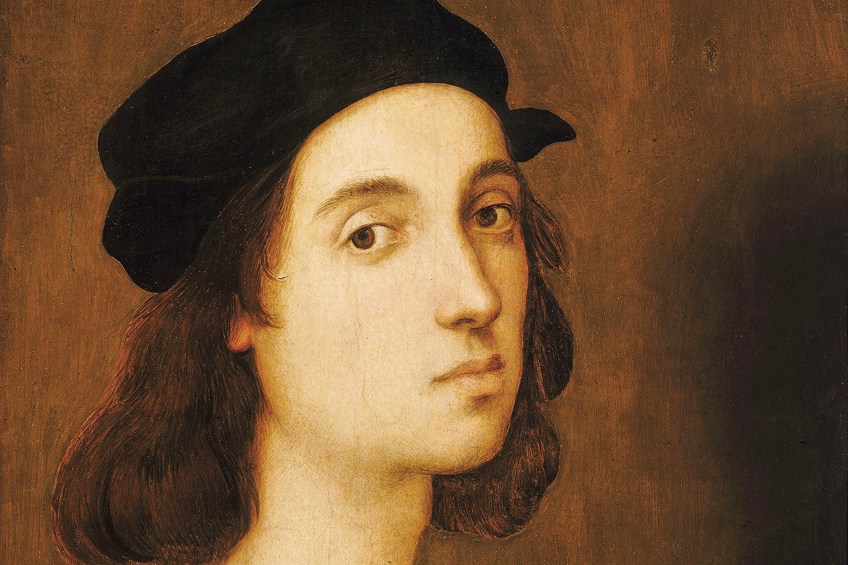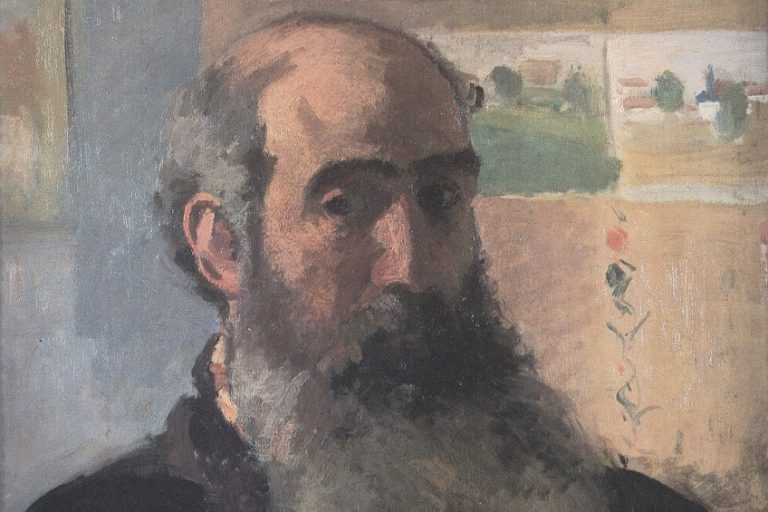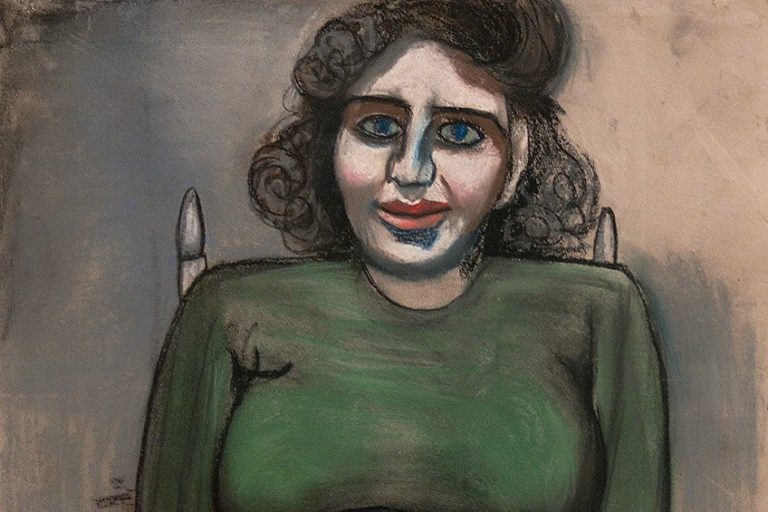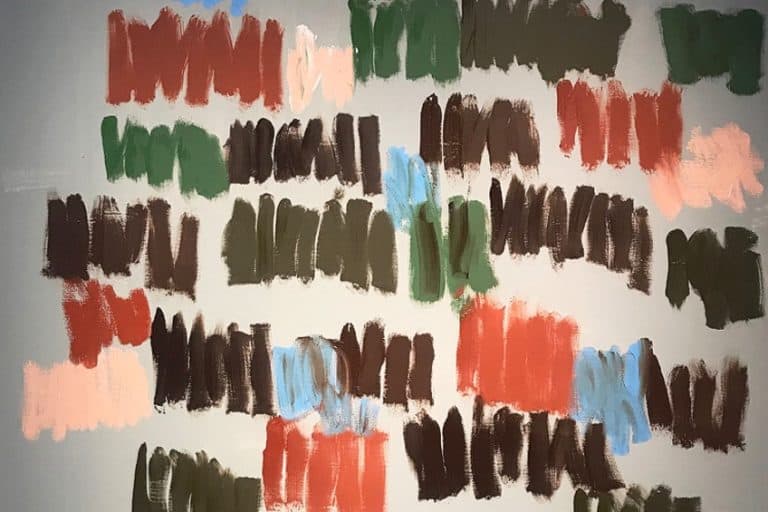Raffaello Sanzio da Urbino – Who Was Raphael and Why Is He Famous?
Who was Raphael? Raphael, the Renaissance artist and architect from Italy, was born Raffaello Sanzio da Urbino. What was Raphael known for? His art is praised for its purity of form, simplicity of composition, and visual realization of the Neoplatonic concept of human greatness.
A Raphael Biography
| Nationality | Italian |
| Date of Birth | 28 March 1483 |
| Date of Death | 6 April 1520 |
| Place of Birth | Urbino, Duchy of Urbino |
Raffaello Sanzio da Urbino was a prolific artist who had an abnormally large studio and left a large collection of works despite his premature death at the age of 37. But when was Raphael born and how did Raphael die? Let us learn more by exploring Raphael’s biography.
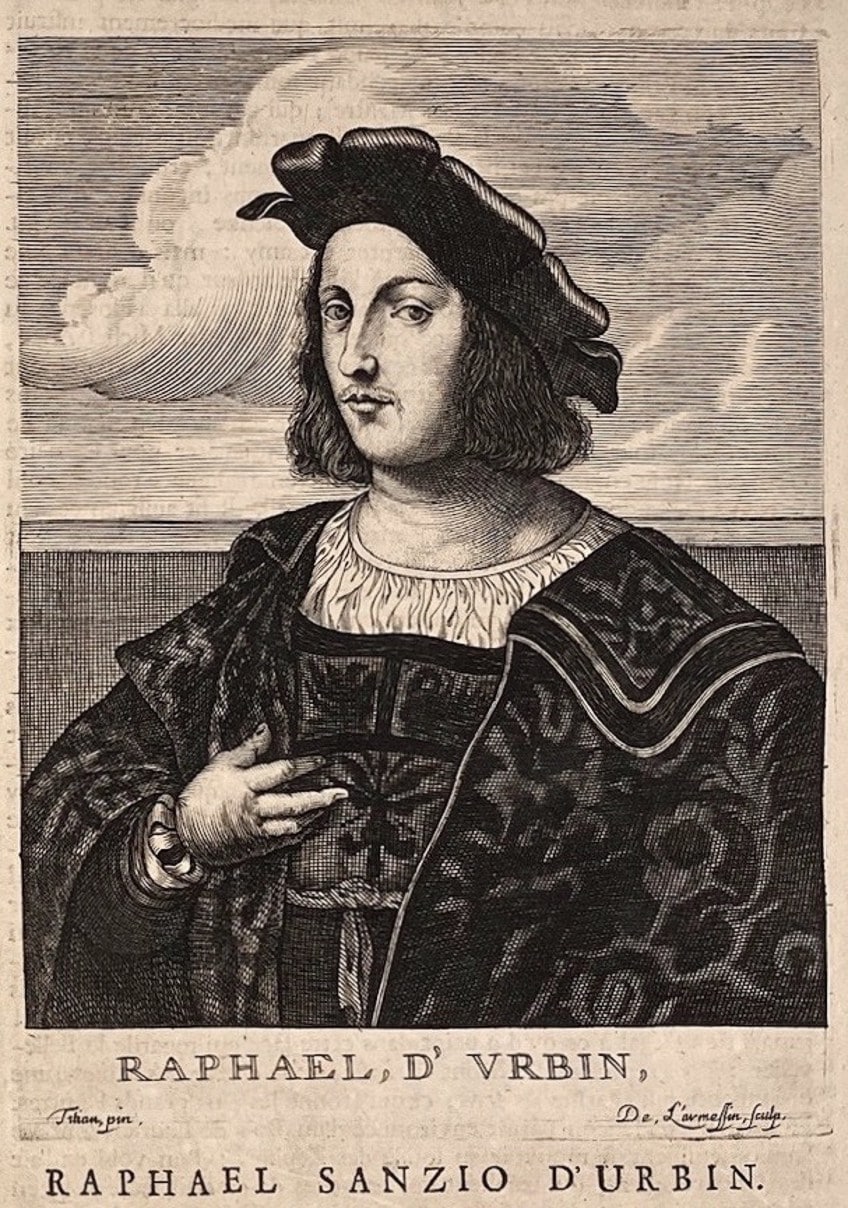
Childhood
Raphael was born in 1483, to a wealthy trader household from Urbino. During a time when Urbino was a thriving cultural center, Raphael’s father, Giovanni Santi, flourished as an artist for Federigo da Montefeltro, where he was the head of a renowned studio. Raffaello Sanzio da Urbino was the only one of his siblings who made it through childhood alive. Raphael’s mother passed away when he was only nine years old in 1491, and his father remarried the next year.
Raphael learned to paint from his father from an early age.
According to his historian Giorgio Vasari, Raphael was also placed in the studio of Italian Renaissance artist Pietro Perugino when he was eight years old. Although we cannot determine when his training began, we do know that in 1494, the year his father died, he was serving as an apprentice at Perugino’s studio. After Giovanni’s passing, Raphael acquired his father’s workshop, and Giovanni’s brother was declared Raphael’s legal guardian. Raphael continued to operate in his father’s business while his uncle took over as studio manager.
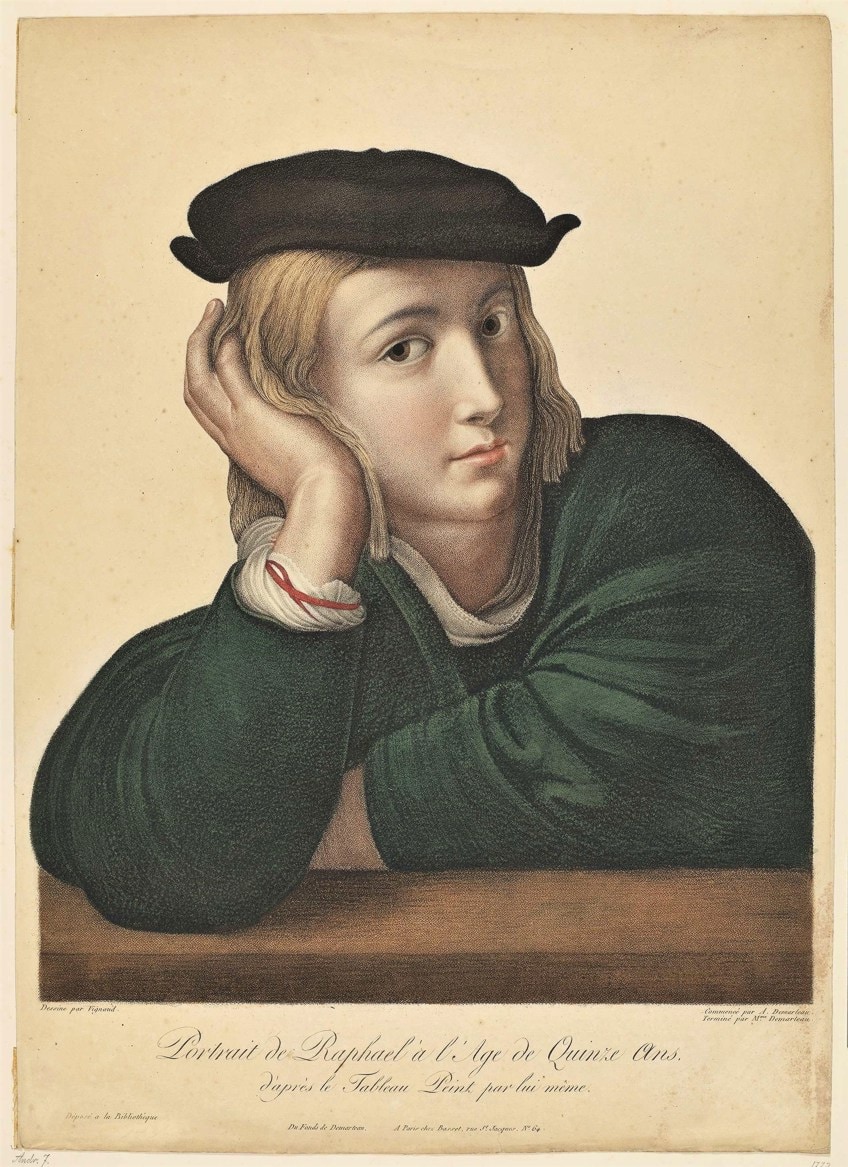
Early Life
Raphael was later taught by Timoteo Viti, a royal painter in Urbino, although Perugino is often recognized as Raphael’s first important artistic influence. His exceptional painting ability, along with the completion of his apprenticeship, gained him the title of the true master while he was still just 17 years old.
It was difficult to detect the distinction between Perugino’s and Raphael’s hands with respect to style and approach at the time.
Raphael got his very first contract, an altarpiece honoring St. Nicholas of Tolentino, in the year 1500. Notwithstanding a collaborative work with Evangelista da Pian di Meleto, Raphael was referred to as “Master.” Tragically, an earthquake in 1789 destroyed the altarpiece, and only fragments remain today, spread in museums throughout the world.

Raphael arrived in Siena in 1504 after being commissioned to produce frescos for the Libreria Piccolomini by the painter Pinturicchio. He subsequently relocated to Florence, the pulsating heart of the Italian Renaissance, for the following several years.
Throughout this period, he met his two primary opponents, Michelangelo and Leonardo da Vinci; despite the fact that Raphael was much younger, the three were known as the core trio of great masters of the age.
In Florence, Fra Bartolomeo persuaded Raphael to renounce Perugino’s delicate, graceful style in favor of a grander one. His greatest creative inspiration was Leonardo da Vinci, notably his compositions, use of motion to build conversation, and groundbreaking chiaroscuro and sfumato techniques. Based on this influence, Raphael began to develop his own style, which quickly acquired adulation for its clarity of structure, pureness of form, and stylistic achievement, all of which were notable inclusions to the Neoplatonic ambitions of human magnificence and Renaissance efforts toward conveying beauty.

During this period, Raphael painted a series of Madonnas that encompassed much of da Vinci’s efforts with reality and composition. The most famous instance is his painting La belle jardinière, which was completed in 1507.
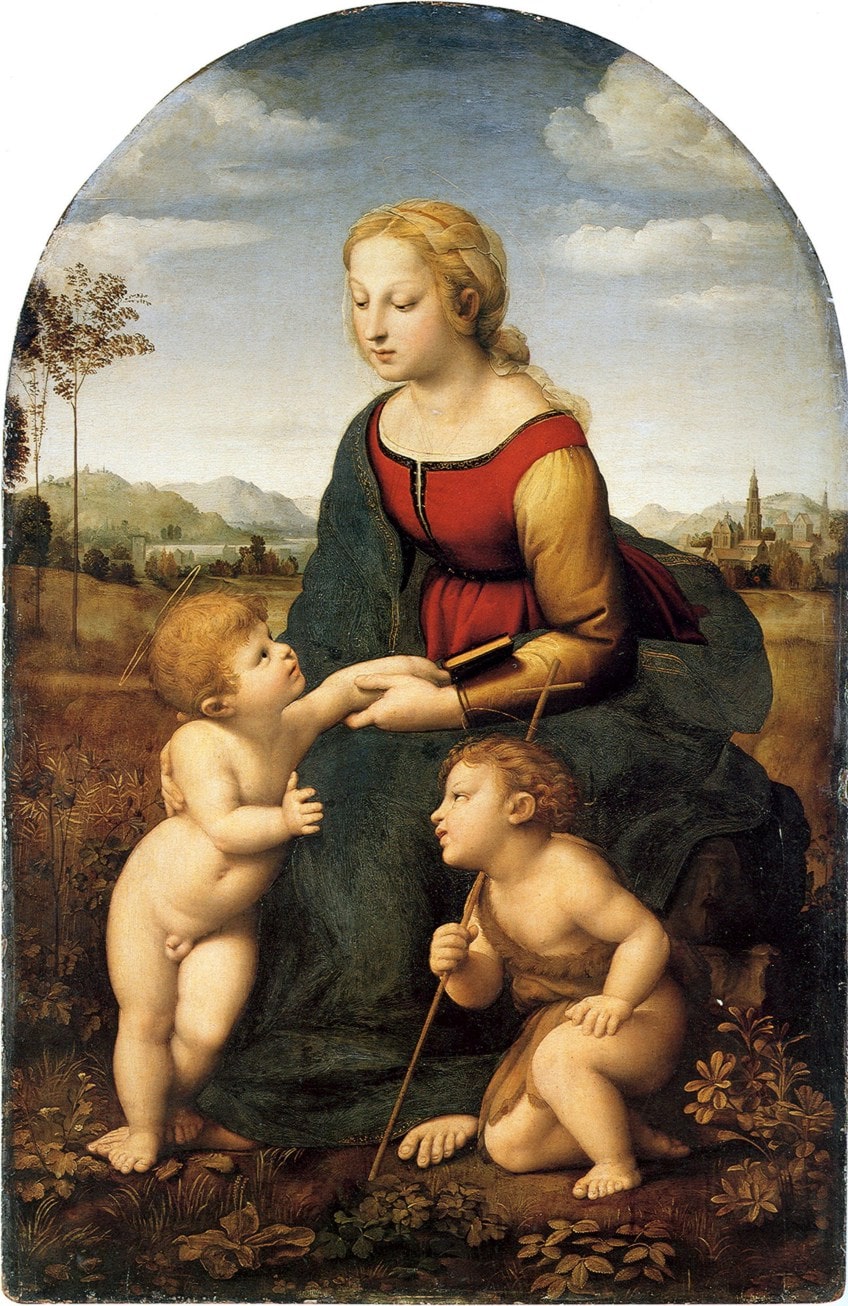
He created similarities to Michelangelo’s 1504 Battle of Cascina in his The Entombment later that year. Michelangelo was said to have been infuriated by Raphael’s ability to absorb information from other artists and transform it into his own distinct style, driving the erratic artist to charge Raphael with plagiarism.
Mid-Life Career
Pope Julius II requested that Raphael travel to Rome. It would be his adopted home for the following 12 years. During this time, he painted for both Pope Julius II and Pope Leo X, earning the title “Prince of Painters.” In 1508, while Michelangelo was creating the ceiling of the Sistine Chapel, Raphael started refurbishing Pope Julius II’s chambers at the Vatican. This was his most significant commission to date, and it secured his place as the Medici Court’s foremost painter.
Despite spending the next five years working on the frescos, he handed the commission to his assistants, who worked from his drawings.
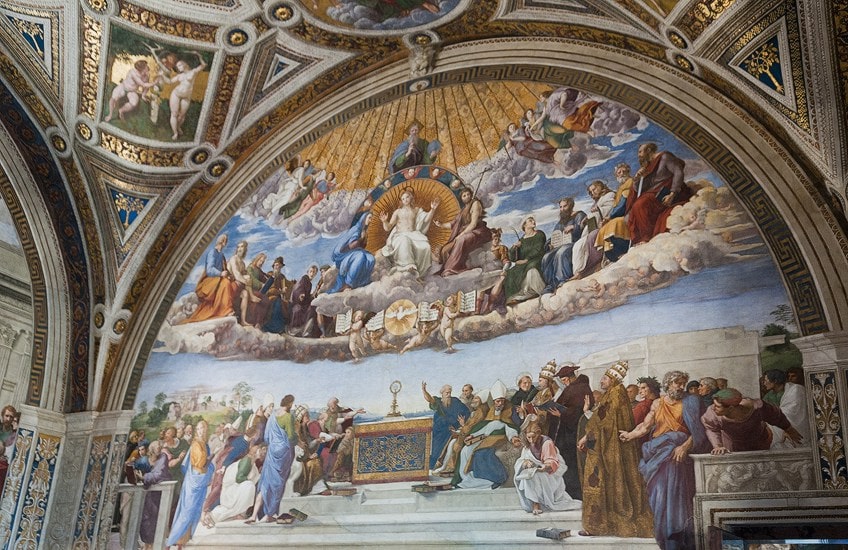
At this time, Raphael met the businessman Agostino Chigi, who became one of his most important sponsors outside the church. The painting of Galatea in Chigi’s Villa Farnesina in Rome, designed by architect Baldassarre Peruzzi, is his most famous commission.

Agostino Chigi awarded Raphael his first architectural commission in 1513, the creation of the Chigi Chapel in the Santa Maria del Popolo church. Later, he worked with Bramante on the creation of the St Eligio degli Orefici church in Rome. Bramante’s architectural skills gained him the post of Architectural Commissioner of the reconstructed St Peter’s Basilica after his death in 1514.
In 1514, Raphael married Maria Bibbiena. He was a long-time supporter and friend of the Medici Court, as well as a strong person inside it. He was sheltered by Pope Julius II throughout his pontificate, and he was a companion of Pope Leo X. Raphael approved the offer under much duress due to the fact that he was already liked by Margherita Luti, the daughter of a baker, who then became his lover and muse.
Maria Bibbiena passed away from an unidentified disease in 1520, preventing the marriage, due to the considerable attention on Raphael’s obsession with Margherita Luti.
His greatest love, Margherita Luti, is immortalized in Raphael’s work La Fornarina (1518-1519). Vasari claims that Raphael’s soul was not in his works when he was ordered to embellish the Villa Farnesina for Agostino Chigi because of his passion for her. Chigi had to organize for the couple to see each other covertly during the job. Raphael’s use of love and marriage symbols throughout the Villa has inspired rumors that the couple was secretly married.
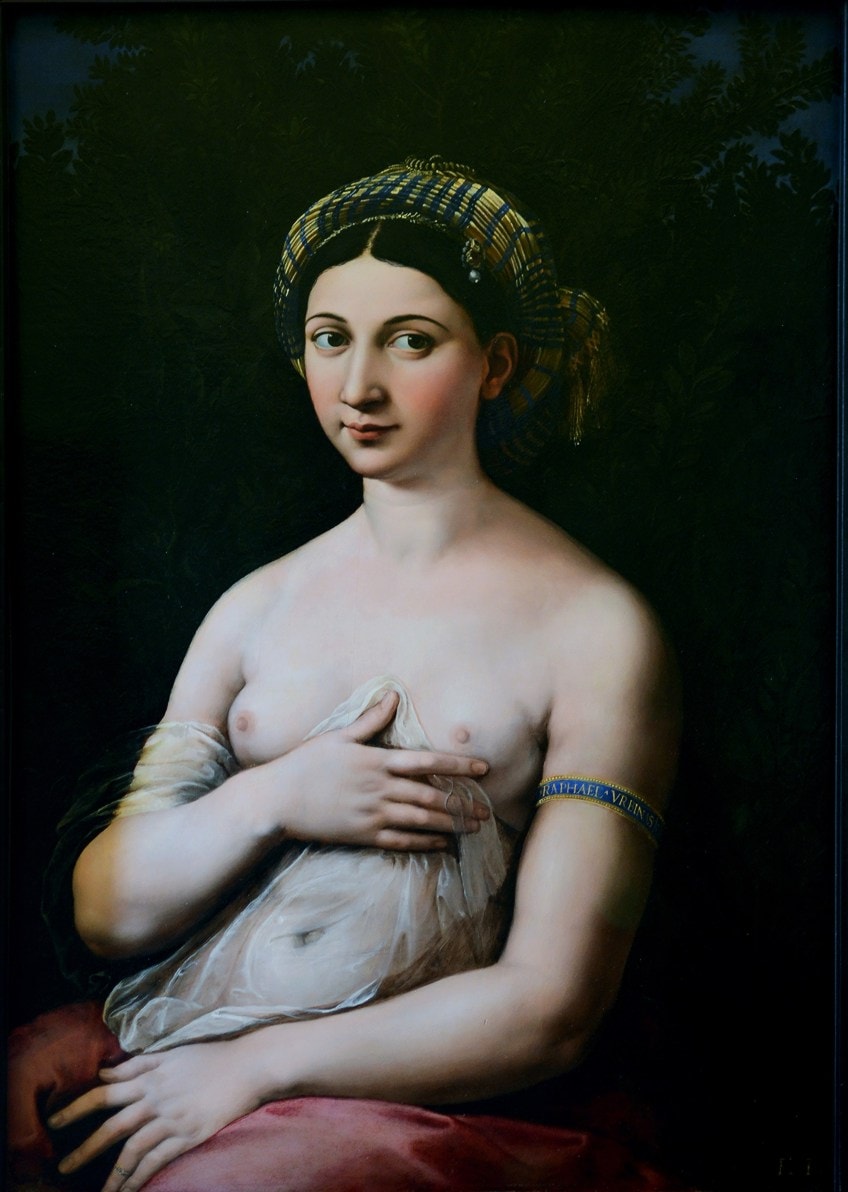
Late Life
Pope Leo X named Raphael as commissioner of antiquities in 1517, tasked with the responsibility of supervising antiquity restoration. To fulfill his mission, Raphael began by creating an archaeological map of Rome. His preservation methods stood out from those of earlier restorers since he focused on keeping artifacts in their original state rather than the inventive restorations fashionable at the time. The Pope also requested that Raphael produce ten tapestries for the Sistine Chapel’s walls.
Raphael finished seven drawings (full-sized preparatory sketches) and had them woven by Pieter Coecke van Aelst, a Flemish weaver.
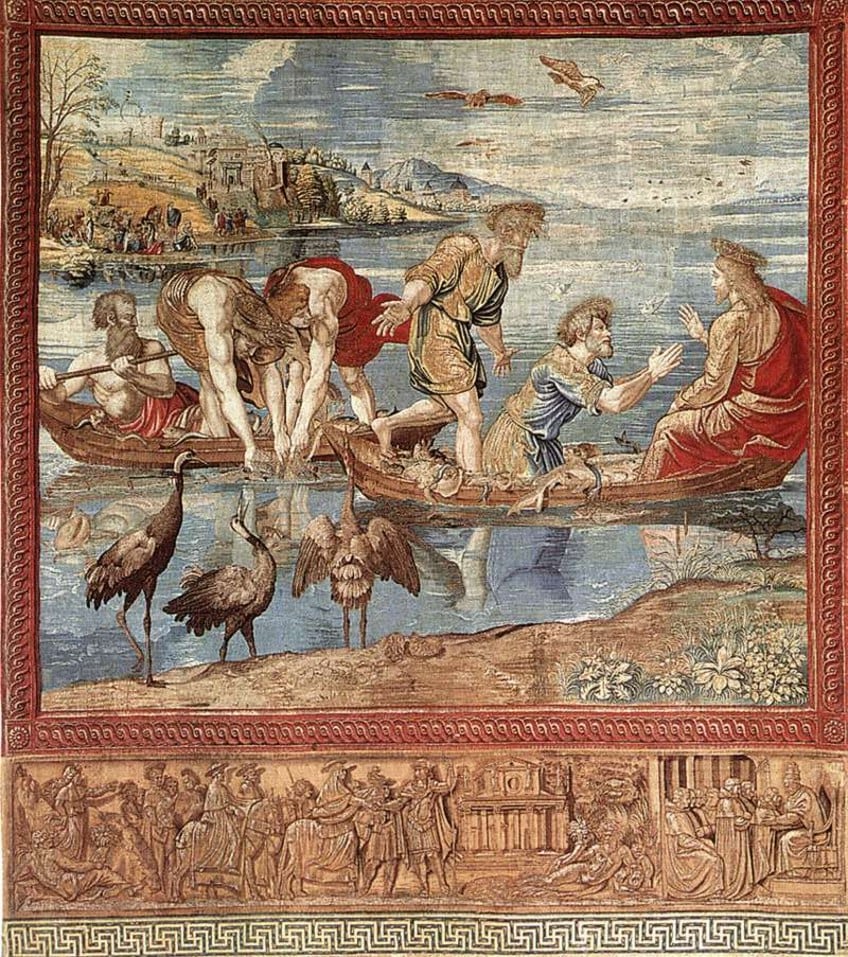
They were placed in the chapel just before Raphael’s passing. Raphael spent the latter years of his life in the Palazzo Caprini, a house created by Bramante. He was awarded various honors during this period, such as the title of Groom of the Chamber, an important post at the Papal Court.
There’s also the Villa Madama, a country retreat built by Cardinal Giulio de’ Medici, subsequently Pope Clement VII, but this was abandoned after he died. The Transfiguration (1516-1520), funded by Cardinal Giulio de’ Medici and intended for a large altarpiece in France’s Narbonne Cathedral, was the last painting he completed before his death.
By the time he passed, Raphael was said to have a studio of more than 50 trainees, which was more than any other artist at the time.

Raphael passed away suddenly aged 37 on the 6th of April, 1520. He died after a brief illness that allowed him to finalize his estate and obtain his last rites. His remains were laid in state at his home, followed by one of the largest funeral ceremonial occasions of the time, concluding in a funeral mass at the Vatican, as per local tradition.
The actual magnificence of the procession was the vast crowd of friends, students, painters, renowned authors, and dignitaries of all ranks that attended him, amidst the city’s sorrow; for the sadness was universal, and the Pope’s Court shared it.
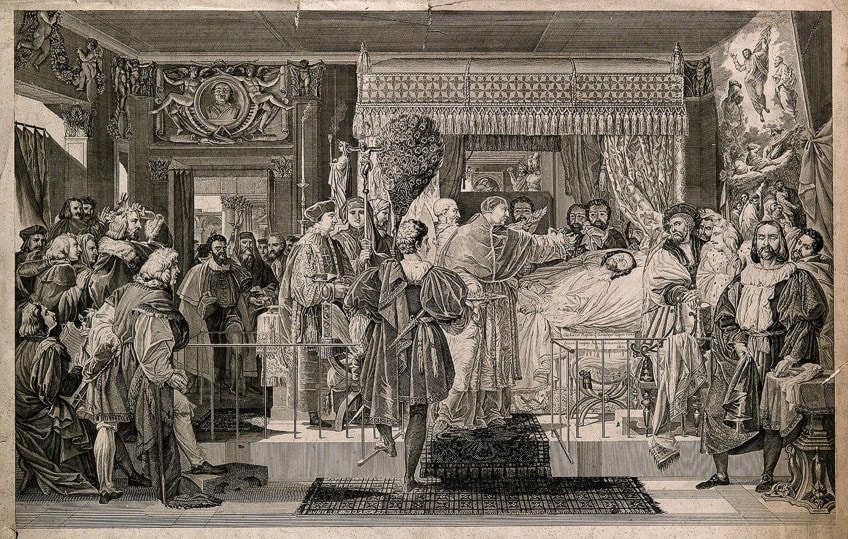
In his testament, Raphael ordered that he be placed next to Maria Bibbiena at the Pantheon in Rome. Despite the fact that he bequeathed a large quantity of wealth to Margherita Luti, nothing is known about her. A widow called Margherita Luti did, however, enter the order of St. Apollonia a few months following his death.
Because of Vasari’s suggestion that Raphael’s death was caused by “depredations of love,” Raphael’s death has sparked significant discussion.
“He was a very passionate individual, who took great pleasure in ladies and was always willing to serve them,” Vasari explained. Despite the widespread acceptance of these ideas, the reason for the death of this brilliant painter remains unexplained. Raphael’s notoriety as a master painter has been reinforced by his prestige as a mannerly gentleman with an inherent self-belief to move in courtly groups, and the capacity to inventively perceive both secular and religious concessions.
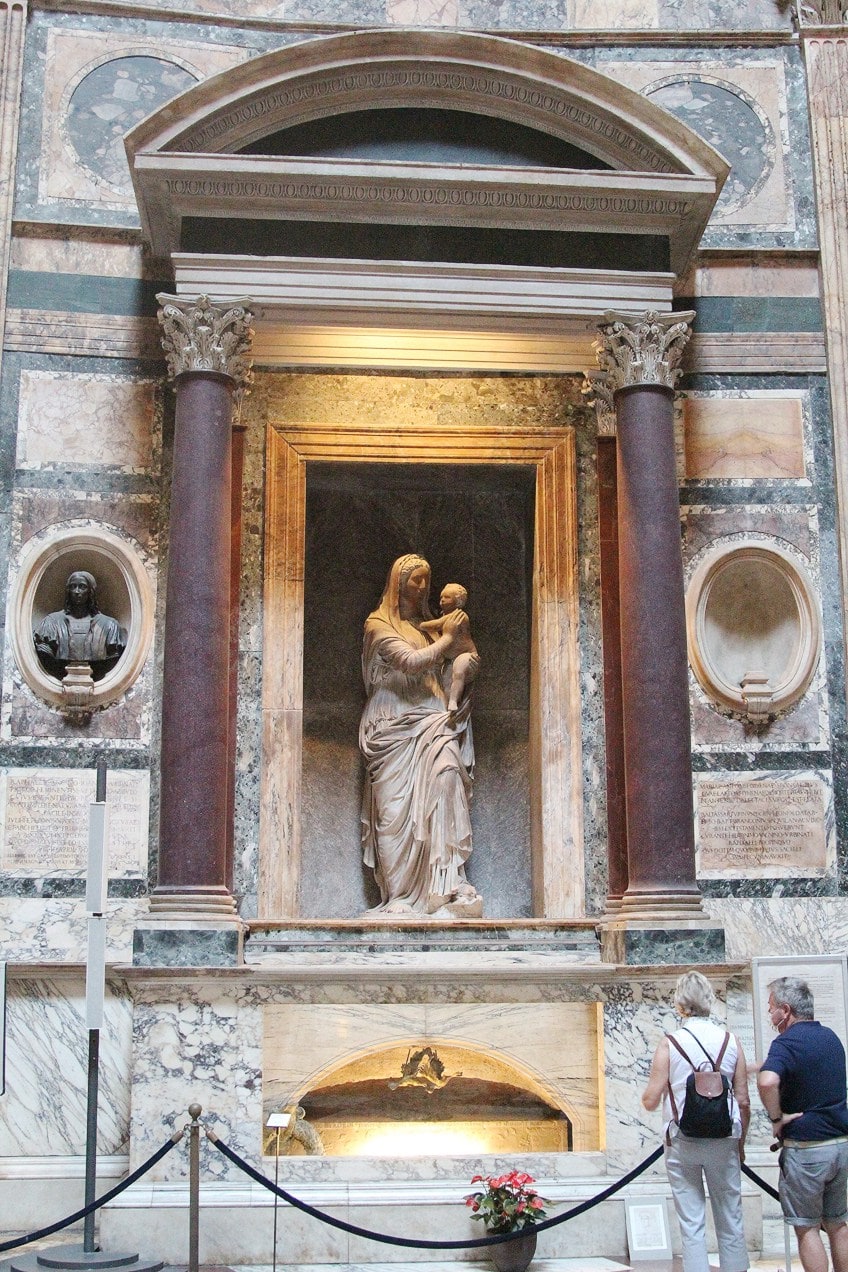
Raphael’s Most Notable Artworks
Despite his short life, Raphael’s great aptitude as a painter was the result of years of training that started when he was a child. He acquired a reputation as one of the most productive painters of his period, from his boyhood devoted to his artist father’s studio through his adult life heading one of the largest workshops of its sort.
Raphael’s works are considered to be among the best examples of the era’s humanist movement, which sought to study man’s place in the world via art that emphasized perfect beauty.
The Marriage of the Virgin (1504)
| Date Completed | 1504 |
| Medium | Oil on panel |
| Dimensions | 174 cm x 121 cm |
| Current Location | Pinacoteca di Brera, Milan |
The picture was influenced by a panel of The Marriage of the Holy Virgin painted by Raphael’s early tutor Perugino. The picture varies from Perugino’s in that it has a more circular arrangement instead of the more frequent horizontal portrayal seen in paintings of the time.
Raphael’s vocation as an artist reaches a defining juncture with this piece, which combines his tutor Perugino’s artistic style with his own rising assurance.
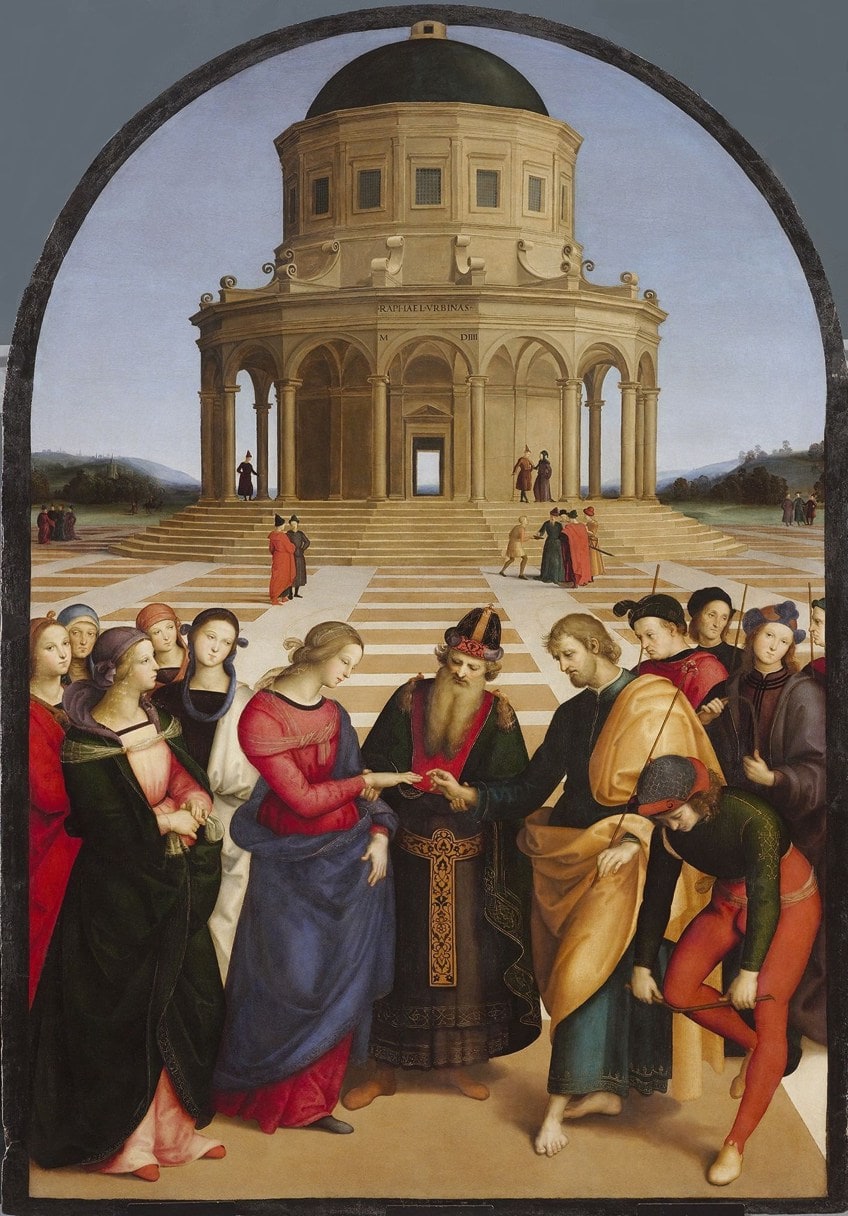
We see him experimenting with structure, perspective, and the bold use of vivid tonal colors, all of which would typify his later artworks. This picture also reflects Raphael’s confidence in establishing his name as a painter, because it is one of his early signed pieces.
It also demonstrates his grasp of Renaissance methods such as the three-point perspective, as we watch the people’s proportions decline as they retreat into the picture, and the sidewalk, which guides us to the shrine.
Disputation of the Holy Sacrament (1509 – 1510)
| Date Completed | 1509-1510 |
| Medium | Fresco |
| Dimensions | 500 cm x 770 cm |
| Current Location | Vatican City |
One of the Vatican’s Apostolic Palace’s four Raphael Rooms, this work is one of four works in the room that show logic, literature, religion, and law individually. It depicts the inmates of a Catholic Church beneath the expanse of heaven over their sacred altar, representing theology.
The artwork portrays Christianity’s victory over philosophy, which is displayed on the opposite wall in Raphael’s 1511 painting “The School of Athens”.
Christ is in the midst of heaven, with the Virgin Mary to his right and John to the left side. Above Christ, God is seen ruling over heaven, with Adam on the left side and Jacob on the right side. The Holy Spirit is seen at Christ’s feet, while Moses is seen carrying the stones with the 10 commandments. Cherubs hold the four gospels along either flank of the Holy Spirit.
The first four Doctors of the Church, are portrayed disputing the Transubstantiation, the supernatural change of the holy eucharist components upon their dedication into the flesh and blood of Christ in the worldly form of wine and bread.
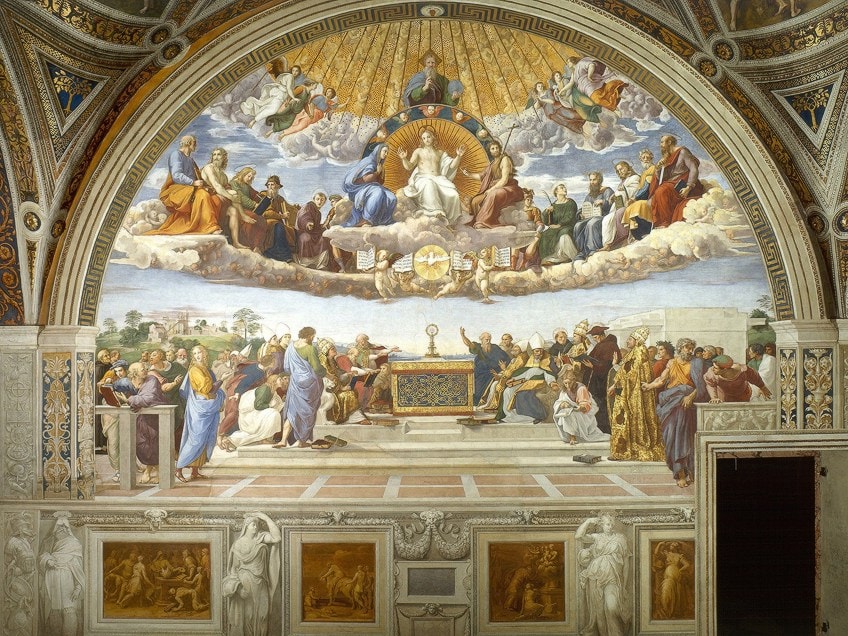
Over 100 individuals are shown in this painting. The Disputation by Raphael is more than a representation of the Eucharist. His first major commission, to refurbish what would become Pope Julius II’s private chambers, was completed when he was just 27 years of age. Unfortunately, it necessitated the removal of frescoes by other significant Renaissance artists such as Piero della Francesca and Raphael’s tutor Perugino.
Julius II used the Stanza della Segnatura as a study and private library, and it got its name from its subsequent usage as the Holy See’s highest court, ruled over by the pope Segnatura Gratiae et Ilustitiae. Raphael won over Michelangelo, who had been engaged in painting the Sistine Chapel at that moment, and Leonardo da Vinci for the contract to paint the four chambers. This infuriated Michelangelo, who went on to condemn Raphael for copying and spread rumors that Raphael had slipped into the Sistine Chapel to observe Michelangelo’s works personally.
Nevertheless, the competitiveness between two extremely talented professionals battling for the same customer’s approval was most likely the source of the hostility.
The School of Athens (1511)
| Date Completed | 1511 |
| Medium | Fresco |
| Dimensions | 500 cm x 770 cm |
| Current Location | Vatican City |
What is important is how Raphael has gathered all of the greatest ancient ideas into a beautiful Renaissance cathedral whose architecture refers to Bramante’s designs for the prospective St Peter’s Basilica. Many of the intellectuals are recognized by their iconography, which is taken from busts discovered during archaeological digs and would have been well understood in the period. Plato (thought to be a picture of Leonardo painted in reverence) and Aristotle are seen in the center, holding their respective books Timeus and Ethics.
The professor bending over Pythagoras is claimed to represent Averroes, an Arab philosopher who is attributed with conveying Plato and Aristotle’s teachings to the West. As a dig at his great competitor Michelangelo, Raphael is claimed to have portrayed his portrait as the visage of the Philosopher Heraclitus lying on a block of stone.
Heraclitus is regarded as the sobbing thinker because of the mournful tone of his philosophical thought, which relates to Michelangelo’s own proclivity for suffering baby-like episodes.
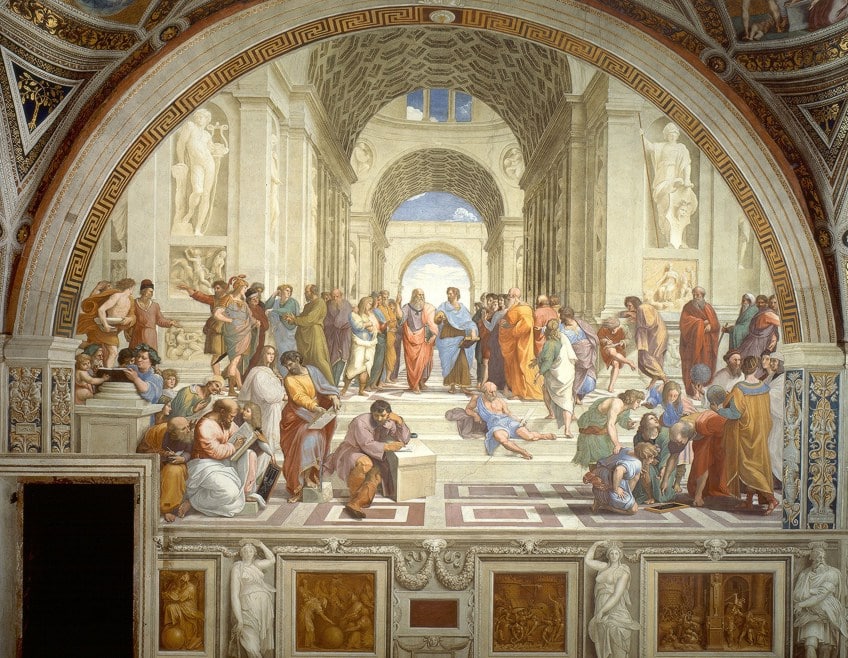
In the right corner of the painting, a self-portrait of Raphael wearing a black beret sits next to another painter and colleague Il Sodoma, who was one of the artists whose artwork Raphael was ordered to paint over. The fresco employs several Renaissance tactics, such as inviting spectators to join the room as though they are totally immersed in the scenario in an almost dramatic manner. As though we were also involved in the discussion or contemplation, the viewpoint draws us into the crowd. The scene is filled with sunlight from the window in the piece’s backdrop, emphasizing its three-dimensional solidity.
The high vaulted ceiling with a view of the sky creates the impression that we are entering the domain of superhuman intellect and action, heightening the sensation of awe that comes with being in the company of those who have played such a significant role in creating our knowledge of the universe.
The colors are subdued so that there is no one point of interest. Instead, we sense the entire composition as a universe that lives in a plane of time further than that which we name our own, showcasing Raphael’s mastery of color. The narrative features of the four frescos are properly positioned to engage in interaction with one another, making the space suitable for use as a library.
Recommended Reading
Would you like to learn more about Raphael’s biography and art? Maybe you would like to read Raphael’s quotes about art. Here is a list of books that will educate you further about Raphael the Renaissance artist.
The Exoteric Meaning in Raphael’s Paintings (2006) by Giorgio Spadaro
The germ for this book was sown in 1941, when Giorgio Spadaro and his cousin, the painter Beppe Assenza, went to the Vatican Museums for the first time. In 1945, a second visit and more chats sowed the seed, which flourished for more than half a century.
It has now blossomed into this profound and approachable reflection on the religious meaning of three of Raphael’s best works.
Spadaro’s mindfulness uncovers a prescient Raphael whose works of art have much to instruct us about the progression of consciousness, the involvement of the Gospel and Religion in evolutionary history, and the route of personal inner development by continuing to work intently, calmly, and cautiously through its structure and the symmetry it embodies.
- Attentive, patient, and careful studies of Raphael's compositions
- Shows how Raphael’s paintings depict the states of humanity
- A valuable addition to the growing body of literature on Raphael
Raphael (2016) by Christof Thoenes
This vital introduction explains how Raphael created his way to legendary status in barely two decades of labor. It demonstrates the mastery of figures and forms that guaranteed his place not just in the trinity of Renaissance geniuses, but also among the most acclaimed painters of all time, via highlights from his prodigious oeuvre. Raphael worked across central Italy, mainly in Florence, where he made a name for himself as a painter of portraits.
Raphael painted a meteor’s wake of artworks during the Italian High Renaissance’s zenith, despite only having 37 highly creative years. His real joy for life poured out into the canvas, where his expertise in portraying Renaissance Humanist concepts of beauty was amazing. One of Raphael’s quotes gives us insight into his process: “When I am creating art, I do not think.”
Take a look at our Raffaello Sanzio webstory here!
Frequently Asked Questions
Who Was Raphael?
Raffaello Sanzio da Urbino was the Italian Renaissance artist and architect Raphael. His works are recognized for their purity of form, simplicity of composition, and visual expression of the Neoplatonic notion of human grandeur. Despite his untimely death at the age of 37, Raffaello Sanzio da Urbino was a prolific artist with an unusually big studio and a vast collection of works.
When Was Raphael Born?
This might seem like a straightforward question. However, there are two possible dates for this famous artist’s birth. The one is on the 28th of March in 1483, and the other is on the 6th of April.
What Was Raphael Known For?
Raphael not only mastered High Renaissance techniques such as sfumato, perspective, accurate anatomical precision, and genuine emotionality and expression, but he also established a distinct style characterized by clarity, rich color, simple composition, and grandeur. In terms of acceptability and employment possibilities, his social ease and nice disposition offered him an advantage over his classmates.
How Did Raphael Die?
The Renaissance artist passed away after a short illness that enabled him to complete his estate and get his last rites. His ashes were placed to rest in his residence, followed by one of the most elaborate burial ceremonies of the period, culminating in a funeral mass at the Vatican, as was customary. Raphael’s death has aroused a lot of debate.
Isabella studied at the University of Cape Town in South Africa and graduated with a Bachelor of Arts majoring in English Literature & Language and Psychology. Throughout her undergraduate years, she took Art History as an additional subject and absolutely loved it. Building on from her art history knowledge that began in high school, art has always been a particular area of fascination for her. From learning about artworks previously unknown to her, or sharpening her existing understanding of specific works, the ability to continue learning within this interesting sphere excites her greatly.
Her focal points of interest in art history encompass profiling specific artists and art movements, as it is these areas where she is able to really dig deep into the rich narrative of the art world. Additionally, she particularly enjoys exploring the different artistic styles of the 20th century, as well as the important impact that female artists have had on the development of art history.
Learn more about Isabella Meyer and the Art in Context Team.
Cite this Article
Isabella, Meyer, “Raffaello Sanzio da Urbino – Who Was Raphael and Why Is He Famous?.” Art in Context. May 19, 2022. URL: https://artincontext.org/raffaello-sanzio-da-urbino/
Meyer, I. (2022, 19 May). Raffaello Sanzio da Urbino – Who Was Raphael and Why Is He Famous?. Art in Context. https://artincontext.org/raffaello-sanzio-da-urbino/
Meyer, Isabella. “Raffaello Sanzio da Urbino – Who Was Raphael and Why Is He Famous?.” Art in Context, May 19, 2022. https://artincontext.org/raffaello-sanzio-da-urbino/.


